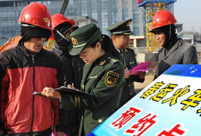 'Jin' named the word of the year by cross-strait netizens
'Jin' named the word of the year by cross-strait netizens Chinese scientific expedition goes to build new Antarctica station
Chinese scientific expedition goes to build new Antarctica station
 Chinese naval escort fleet conducts replenishment in Indian Ocean
Chinese naval escort fleet conducts replenishment in Indian Ocean 17th joint patrol of Mekong River to start
17th joint patrol of Mekong River to start China's moon rover, lander photograph each other
China's moon rover, lander photograph each other Teaming up against polluters
Teaming up against polluters
BEIJING, Dec. 25 -- The number of rural poor in China dropped by nearly 67 million from 2010 to 2012, according to a State Council's report on Wednesday.
By the end of 2012, there were nearly 100 million rural residents still living in poverty, the report said.
Liu Yongfu, director of the State Council Leading Group Office of Poverty Alleviation and Development, delivered the report to lawmakers at a bimonthly session of the Standing Committee of the National People's Congress (NPC), being held from Dec. 23 to 28.
Per capita annual net income in key poverty counties increased from 3,273 yuan (537 U.S. dollars) to 4,602 yuan (753 U.S. dollars) in the 2010 to 2012 period, an annual growth of 18.6 percent.
Infrastructure in these areas has constantly improved, said the report. A highway linking Tibet's Medog County, the last roadless county in China, opened to traffic in October 2013.
Rural education has moved forward. At the end of 2012, 97 percent of children at age of 7-15 in key counties had attended school.
A development-oriented poverty reduction outline for rural China (2011-2020), which was promulgated in 2011, set the per capita annual net income of 2,300 yuan as the new rural poverty threshold, significantly up on the original standard.
In 2011, central government put 227.2 billion yuan into the poverty relief fund, up 40.4 percent from the previous year. In 2012, the figure reached 299.6 billion yuan, up 31.9 percent year-on-year.
Prosperous provinces and cities have shared fiscal funds with disadvantaged provinces and cities to help fight poverty, the report said, citing the example of east China's Fujian Province support for northwest China's Ningxia Hui Autonomous Region.
The central government pushed forward economic development in Tibet Autonomous Region and Xinjiang Uygur Autonomous Region, the report said.
Challenges still exist. Many children in remote areas walk two to three hours a day to school.
Medical expenses in poor counties are 60 percent of the average rural level. Many are unable to see doctors when necessary, Liu said in the report.
The poverty stricken areas are usually ecologically fragile, making poverty relief more difficult. Many rural people are dragged into poverty by natural disasters or ill health.
To better fight the problems, the official performance assessment system should be adjusted in the key counties, to ensure local officials put more emphasis on poverty relief.
A national poverty relief information database will be established to get a better picture of the overall poverty situation and make the work more specific.
Efforts will also be made to make better use of funds and improve supervision of spending.
Other major poverty-relief measures include promoting employment, building more roads, ensuring water safety and electricity supply, repairing dilapidated rural houses and developing rural tourism in the poverty-stricken areas, according to the report.
Special attention will be given to ethnic minorities, women, children and the disabled, it said.
Legislation on rural poverty alleviation will also be strengthened, it said.
 People prepare for upcoming 'Chunyun'
People prepare for upcoming 'Chunyun'  Highlights of Beijing int'l luxury show
Highlights of Beijing int'l luxury show Record of Chinese expressions in 2013
Record of Chinese expressions in 2013 China's moon rover, lander photograph each other
China's moon rover, lander photograph each other 17th joint patrol of Mekong River to start
17th joint patrol of Mekong River to start Spring City Kunming witnesses snowfall
Spring City Kunming witnesses snowfall Heritage of Jinghu, arts of strings
Heritage of Jinghu, arts of strings Weekly Sports Photos
Weekly Sports Photos PLA elite units unveiled
PLA elite units unveiled  China's stealth fighters hold drill over plateau
China's stealth fighters hold drill over plateau Chinese navy hospital ship's mission
Chinese navy hospital ship's mission  "Free lunch" program initiated in NW China
"Free lunch" program initiated in NW China  Rime scenery in Mount Huangshan
Rime scenery in Mount Huangshan DPRK's Kaesong Industrial Complex
DPRK's Kaesong Industrial Complex 'Jin' named the word of the year
'Jin' named the word of the year Day|Week|Month